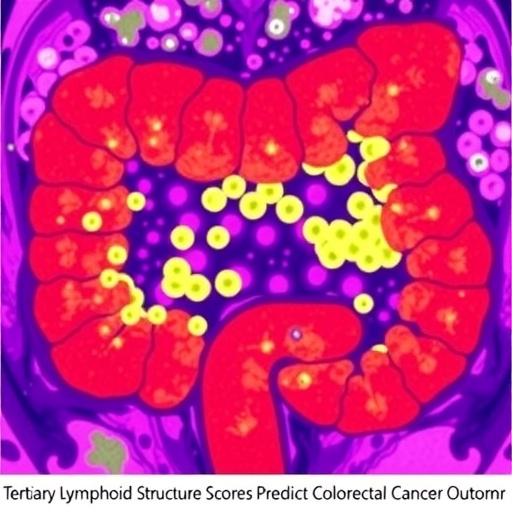Tertiary lymphoid structures (TLSs) have emerged as critical players in orchestrating the immune system’s response to cancer, yet their complex roles in colorectal cancer (CRC) prognosis have remained elusive. A groundbreaking retrospective study led by Shen et al. challenges prevailing assumptions by revealing nuanced insights into how TLS scores and the maturation stages of these lymphoid aggregates influence patient outcomes. Leveraging robust datasets and thorough clinical validation, this research offers promising avenues to refine prognostic models and therapeutic approaches in CRC, a malignancy that continues to impose a significant global health burden.
Colorectal cancer ranks among the leading causes of cancer-related deaths worldwide, primarily due to its heterogeneity and the often late diagnosis. Immune cells infiltrating the tumor microenvironment have gained attention as modulators of tumor progression and responses to treatment. Among these immune infiltrates, TLSs—ectopic lymphoid formations resembling secondary lymphoid organs—have been proposed to promote anti-tumor immunity. The new study comprehensively examines the implications of not just TLS presence but their quantitative scoring and developmental stages, aspects that have, until now, received limited rigorous evaluation in CRC.
The investigation began with an in-depth analysis of the comprehensive TCGA (The Cancer Genome Atlas) colorectal cancer database. The researchers developed a TLS scoring metric and stratified patients into high and low TLS score groups. Remarkably, patients with a high TLS score, defined as 0.752 or higher, exhibited a significantly enhanced overall survival, with a hazard ratio (HR) of 0.381 and a 95% confidence interval ranging from 0.222 to 0.656. These metrics strongly suggest that a robust presence of TLS correlates with better long-term outcomes, supporting the notion that TLSs contribute positively to immune-mediated tumor suppression.
.adsslot_t8TS9U0FNd{ width:728px !important; height:90px !important; }
@media (max-width:1199px) { .adsslot_t8TS9U0FNd{ width:468px !important; height:60px !important; } }
@media (max-width:767px) { .adsslot_t8TS9U0FNd{ width:320px !important; height:50px !important; } }
ADVERTISEMENT
Delving deeper into the molecular underpinnings, the team identified chemokines CCL19, CCL21, and CXCL13 as differential expression markers distinguishing high TLS score patients from their low-score counterparts. These chemokines are well-known chemoattractants implicated in the structural organization and maturation of TLS. Their elevated expression underscores a sophisticated immune recruitment and coaxing process within the tumor microenvironment, potentially enhancing effective lymphocyte aggregation and antitumor activity.
To translate bioinformatics findings into clinical relevance, Shen et al. conducted immunohistochemical analyses on 76 clinical CRC samples. This pivotal step mapped TLS to specific maturation stages, differentiating early TLS (E-TLS) structures from secondary follicular-like TLS. Intriguingly, high density of E-TLS was paradoxically associated with poorer survival outcomes. Patients exhibiting increased E-TLS densities showed significantly shorter survival times, with a hazard ratio of 6.40 (95% CI: 1.82–22.55), suggesting that immature TLS may not uniformly bolster antitumor immunity.
This counterintuitive observation challenges the simplistic dichotomy that more TLS equates invariably to better prognosis. Immature TLS may, in fact, foster a microenvironment conducive to tumor persistence or immune evasion. Alternatively, E-TLS abundance might reflect a systemic immunosuppressive state or early but ineffective immune activation. Notably, the density of secondary follicular-like TLS did not demonstrate prognostic significance in this cohort, hinting that the mere presence of mature TLS is insufficient alone without considering their functional context or spatial dynamics.
A molecular spotlight in the study was cast on the TNFRSF17 gene, also known as BCMA, a receptor intimately linked to B cell regulation and survival. Increased expression of TNFRSF17 was observed in tumors with high TLS scores and was associated with mechanisms that promote T-cell infiltration and adhesion within the tumor stroma. Functional cellular experiments validated the gene’s role, positioning TNFRSF17 as a potential mediator or biomarker of the immunological milieu shaped by mature TLS.
Furthermore, tumors with elevated TLS scores demonstrated upregulated expression of immune checkpoint genes. This is a double-edged finding, as it aligns with enhanced immune cell presence but also suggests the potential for immune exhaustion or suppression mediated through checkpoint pathways such as PD-1/PD-L1 or CTLA-4. The interplay between TLS-mediated immune activation and checkpoint expression may open new therapeutic windows, in which checkpoint inhibitors could be strategically deployed according to TLS maturation profiles.
This study’s insights pave the way for a sophisticated understanding of how spatial and functional heterogeneity within the immune landscape of CRC tumors impacts patient survival. It calls for more nuanced immunophenotyping in clinical practice, moving beyond simplistic presence-absence frameworks to incorporate TLS scoring and maturation stages as integral parts of precision oncology paradigms.
The implications extend beyond prognostication to therapeutic strategies. If E-TLS aggregates indeed impair survival, interventions that promote TLS maturation or modulate chemokine signaling pathways might recalibrate the tumor-immune interface toward effective antitumor immunity. Conversely, direct targeting of mechanisms underlying immature TLS formation or their downstream suppressive influences might mitigate adverse effects linked to high E-TLS density.
Combining transcriptomic data with cellular experimentation, the study exemplifies a translational research approach that bridges computational biology, pathology, and immunology. By validating findings within patient-derived materials, the authors ensure that their conclusions bear direct clinical relevance, inviting future investigations into TLS-targeted therapies or biomarker-driven clinical trial designs.
Importantly, the retrospective nature of the study does warrant cautious interpretation, and prospective studies with larger patient cohorts and diverse populations are essential to confirm generalizability. Nonetheless, the strong statistical associations and biological plausibility provide a compelling framework to refine immunoprofiling in CRC.
In an era where immunotherapies are revolutionizing cancer treatment, decoding the precise contributions of TLS to immune surveillance may be a linchpin in optimizing therapeutic efficacy. This study provides a tangible foundation to delineate which TLS characteristics are beneficial and which might subvert antitumor immunity, influencing both frontline and adjuvant treatment planning.
Future research avenues could explore how TLS maturation interacts with other hallmark processes of CRC progression, including microsatellite instability status, mutational burden, and stromal composition. Additionally, the impact of microbiome-mediated modulation of TLS formation in colorectal tumors, given the gut’s rich microbial ecosystem, remains an exciting domain to integrate with immunological findings.
Ultimately, Shen et al.’s research underscores the paradigm that immune structures within the tumor microenvironment are not monolithic but dynamically evolving entities. Deciphering their developmental nuances informs not only prognosis but also offers strategic targets to harness or inhibit immune mechanisms, thereby personalizing cancer care and improving survival outcomes for colorectal cancer patients worldwide.
Subject of Research: Investigation of tertiary lymphoid structure (TLS) scores and maturation stages and their impact on colorectal cancer prognosis.
Article Title: Impact of tertiary lymphoid structure scores and their stage of maturation on prognosis of colorectal cancer patients.
Article References:
Shen, S., Sun, R., Wang, T. et al. Impact of tertiary lymphoid structure scores and their stage of maturation on prognosis of colorectal cancer patients.
Genes Immun (2025). https://doi.org/10.1038/s41435-025-00346-2
Image Credits: AI Generated
DOI: https://doi.org/10.1038/s41435-025-00346-2
Tags: anti-tumor immunity mechanismscancer-related mortality and colorectal cancercolorectal cancer prognosis and treatmentimmune system response to cancerimplications of TLS maturation stagesprognostic models in cancer researchretrospective study on TLS and CRCTCGA colorectal cancer database analysistertiary lymphoid structures in colorectal cancertherapeutic approaches for colorectal cancerTLS scores and patient outcomestumor microenvironment and immune infiltrates





